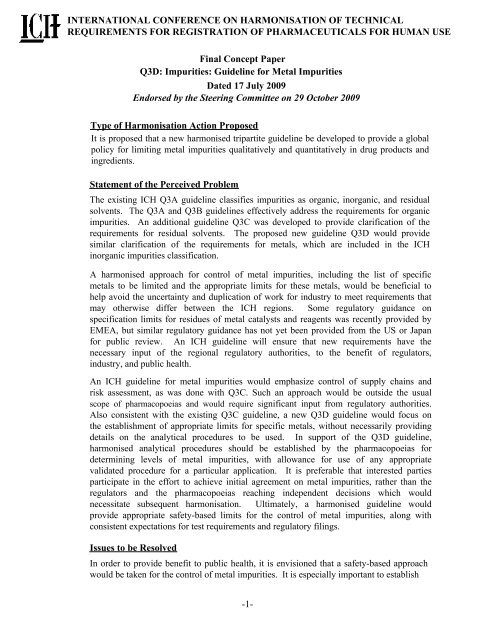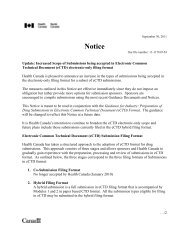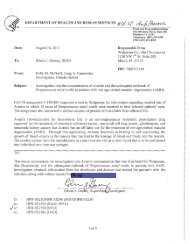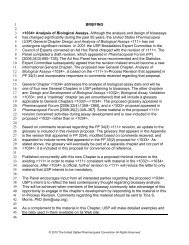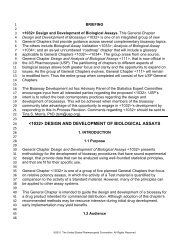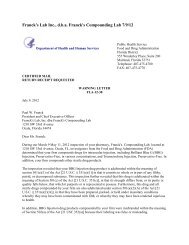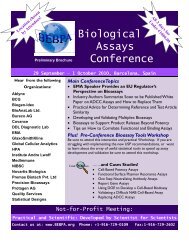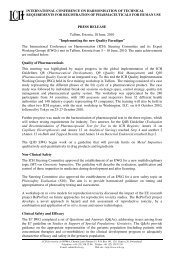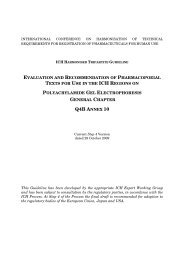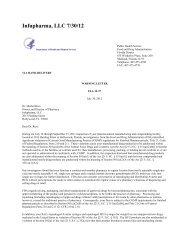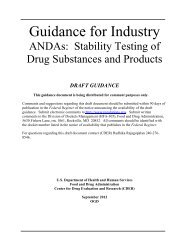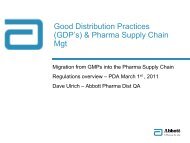concept paper on the Q3D initiative - IPQ
concept paper on the Q3D initiative - IPQ
concept paper on the Q3D initiative - IPQ
You also want an ePaper? Increase the reach of your titles
YUMPU automatically turns print PDFs into web optimized ePapers that Google loves.
INTERNATIONAL CONFERENCE ON HARMONISATION OF TECHNICAL<br />
REQUIREMENTS FOR REGISTRATION OF PHARMACEUTICALS FOR HUMAN USE<br />
Final C<strong>on</strong>cept Paper<br />
<strong>Q3D</strong>: Impurities: Guideline for Metal Impurities<br />
Dated 17 July 2009<br />
Endorsed by <strong>the</strong> Steering Committee <strong>on</strong> 29 October 2009<br />
Type of Harm<strong>on</strong>isati<strong>on</strong> Acti<strong>on</strong> Proposed<br />
It is proposed that a new harm<strong>on</strong>ised tripartite guideline be developed to provide a global<br />
policy for limiting metal impurities qualitatively and quantitatively in drug products and<br />
ingredients.<br />
Statement of <strong>the</strong> Perceived Problem<br />
The existing ICH Q3A guideline classifies impurities as organic, inorganic, and residual<br />
solvents. The Q3A and Q3B guidelines effectively address <strong>the</strong> requirements for organic<br />
impurities. An additi<strong>on</strong>al guideline Q3C was developed to provide clarificati<strong>on</strong> of <strong>the</strong><br />
requirements for residual solvents. The proposed new guideline <strong>Q3D</strong> would provide<br />
similar clarificati<strong>on</strong> of <strong>the</strong> requirements for metals, which are included in <strong>the</strong> ICH<br />
inorganic impurities classificati<strong>on</strong>.<br />
A harm<strong>on</strong>ised approach for c<strong>on</strong>trol of metal impurities, including <strong>the</strong> list of specific<br />
metals to be limited and <strong>the</strong> appropriate limits for <strong>the</strong>se metals, would be beneficial to<br />
help avoid <strong>the</strong> uncertainty and duplicati<strong>on</strong> of work for industry to meet requirements that<br />
may o<strong>the</strong>rwise differ between <strong>the</strong> ICH regi<strong>on</strong>s. Some regulatory guidance <strong>on</strong><br />
specificati<strong>on</strong> limits for residues of metal catalysts and reagents was recently provided by<br />
EMEA, but similar regulatory guidance has not yet been provided from <strong>the</strong> US or Japan<br />
for public review. An ICH guideline will ensure that new requirements have <strong>the</strong><br />
necessary input of <strong>the</strong> regi<strong>on</strong>al regulatory authorities, to <strong>the</strong> benefit of regulators,<br />
industry, and public health.<br />
An ICH guideline for metal impurities would emphasize c<strong>on</strong>trol of supply chains and<br />
risk assessment, as was d<strong>on</strong>e with Q3C. Such an approach would be outside <strong>the</strong> usual<br />
scope of pharmacopoeias and would require significant input from regulatory authorities.<br />
Also c<strong>on</strong>sistent with <strong>the</strong> existing Q3C guideline, a new <strong>Q3D</strong> guideline would focus <strong>on</strong><br />
<strong>the</strong> establishment of appropriate limits for specific metals, without necessarily providing<br />
details <strong>on</strong> <strong>the</strong> analytical procedures to be used. In support of <strong>the</strong> <strong>Q3D</strong> guideline,<br />
harm<strong>on</strong>ised analytical procedures should be established by <strong>the</strong> pharmacopoeias for<br />
determining levels of metal impurities, with allowance for use of any appropriate<br />
validated procedure for a particular applicati<strong>on</strong>. It is preferable that interested parties<br />
participate in <strong>the</strong> effort to achieve initial agreement <strong>on</strong> metal impurities, ra<strong>the</strong>r than <strong>the</strong><br />
regulators and <strong>the</strong> pharmacopoeias reaching independent decisi<strong>on</strong>s which would<br />
necessitate subsequent harm<strong>on</strong>isati<strong>on</strong>. Ultimately, a harm<strong>on</strong>ised guideline would<br />
provide appropriate safety-based limits for <strong>the</strong> c<strong>on</strong>trol of metal impurities, al<strong>on</strong>g with<br />
c<strong>on</strong>sistent expectati<strong>on</strong>s for test requirements and regulatory filings.<br />
Issues to be Resolved<br />
In order to provide benefit to public health, it is envisi<strong>on</strong>ed that a safety-based approach<br />
would be taken for <strong>the</strong> c<strong>on</strong>trol of metal impurities. It is especially important to establish<br />
-1-
FINAL <strong>Q3D</strong> C<strong>on</strong>cept Paper Endorsed: 29 Octobre 2009<br />
appropriate c<strong>on</strong>trols for those metals with clearly established toxicological c<strong>on</strong>cerns.<br />
These metal impurities may arise from <strong>the</strong> drug substances, excipients, or manufacturing<br />
processes used for drug products, and may include catalysts, reagents, ligands, heavy<br />
metals or o<strong>the</strong>r residual metals, such as those due to <strong>the</strong> material source (e.g. Pb, Hg, As,<br />
Cd). With a focus <strong>on</strong> safety of <strong>the</strong> finished dosage form provided to <strong>the</strong> patient, a new<br />
ICH guideline would assure appropriate c<strong>on</strong>trol for <strong>the</strong> specific metals that are likely to<br />
be present in particular drug products and ingredients.<br />
Background to <strong>the</strong> Proposal<br />
Current c<strong>on</strong>trol of metal impurities is primarily based <strong>on</strong> pharmacopoeial requirements<br />
for Heavy Metals, which have been widely used for routine screening of pharmaceutical<br />
ingredients since <strong>the</strong> early 20 th century. The comm<strong>on</strong>ly used methodology was mainly<br />
intended to c<strong>on</strong>trol metals which form a sulphide precipitate, such as lead, copper and<br />
o<strong>the</strong>r metals which were potential c<strong>on</strong>taminants from water pipes, manufacturing<br />
equipment, processes, and o<strong>the</strong>r comm<strong>on</strong> sources. Although <strong>the</strong> risk factors for metal<br />
c<strong>on</strong>taminati<strong>on</strong> have changed dramatically, <strong>the</strong> standards for <strong>the</strong>ir c<strong>on</strong>trol have changed<br />
little for more than 50 years, and most Heavy Metals limits have little basis in<br />
toxicology.<br />
At <strong>the</strong> ICH Meeting in Brussels in November 2008, <strong>the</strong>re was some preliminary<br />
discussi<strong>on</strong> of <strong>the</strong> potential need and benefit of a harm<strong>on</strong>ised guideline for metal<br />
impurities. Previously, <strong>the</strong> Expert Working Group <strong>on</strong> Quality developed <strong>the</strong> Q3A, Q3B,<br />
and Q3C guidelines in order to provide a harm<strong>on</strong>ised approach to limiting impurities.<br />
Toxicologists also provided input <strong>on</strong> <strong>the</strong> subject of impurities, particularly with regard to<br />
toxicity of process-related impurities and residual solvents. The existing ICH guidelines<br />
have generally been incorporated into <strong>the</strong> pharmacopoeial standards dealing with<br />
impurities. Extending this approach to provide a similar harm<strong>on</strong>ised outcome for<br />
addressing metal impurities would avoid different limits being c<strong>on</strong>sidered am<strong>on</strong>g <strong>the</strong><br />
regulatory agencies and <strong>the</strong> pharmacopoeias.<br />
Type of Expert Working Group<br />
It is recommended to form an EWG composed of chemists (with backgrounds in QA and<br />
R&D) al<strong>on</strong>g with toxicologists to develop <strong>the</strong> appropriate guideline for c<strong>on</strong>trol of metal<br />
impurities. The ability to start with <strong>the</strong> EMEA guideline <strong>on</strong> metal impurities, which was<br />
structured in a manner similar to <strong>the</strong> ICH Q3C guideline for residual solvents, should<br />
make it feasible to develop <strong>the</strong> proposed guideline within <strong>on</strong>e to two years of initiati<strong>on</strong><br />
of <strong>the</strong> work.<br />
-2-


